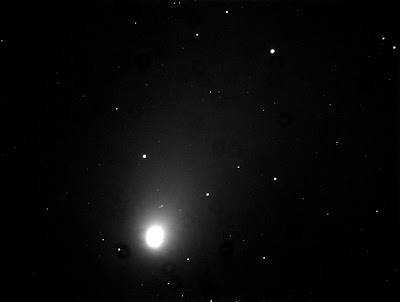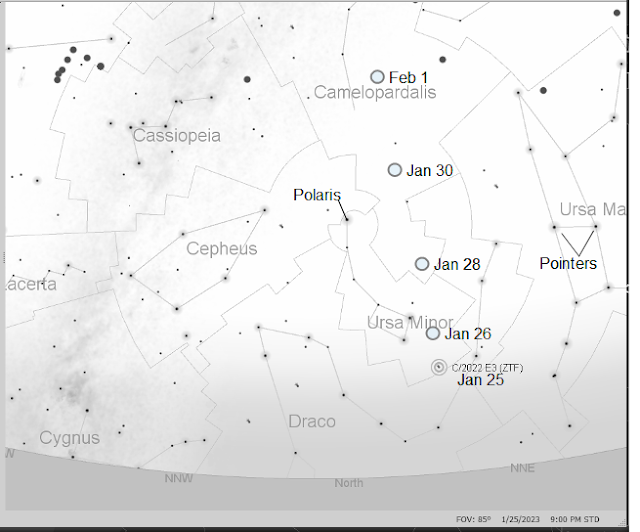Physics Photo of the Week
Comet C/2022 E3 ZTF
Photo by Donald Collins, College View Observatory
I made this photo the night of January 12, 2023 with the College View Observatory 14 inch telescope and CCD camera. This photo consisted of stacking about 10 digital images of 60 seconds each. Compared with the stars, the comet is quite bright, but we can see stars through the dusty tail. The illumination of the comet is reflected light from the Sun.
Astronomers have predicted that this comet may become a bright naked-eye comet. Soon (Feb. 2) it will be the closest to the Earth, but further from the Sun. I don't expect it to become much brighter, but larger in appearance and more diffuse. We'll see.
Comets produce their tails from volatiles and dust being given off from the intensity of the Sun. The sunlight also forces the tail to blow away from the Sun. A smoking match waved gently through the air leaves a tail of smoke indicating where the moving match has been. A comet, when it is traveling away from the Sun follows its tail. If a ship is moving with a wind from astern that is moving toward the bow faster than the ship, the flag on the ship will trail forward. The same phenomenon occurs with a comet traveling away from the Sun. The solar wind (atoms, protons, and electrons that are "boiled" off the Sun due to its tremendous temperature) blows the dust from the comet ahead of the comet.
The animated clip (left) made from first and last image of the stack (they differ in time by 8
minutes) show that the tail is leading the comet. Since the clip consists of only two images, you need to read the time stamps on each frame to see that the comet is moving in the same direction as its tail is pointing.
The projected path of the comet in the sky is shown on a sky map in the third image below. Next week the comet will pass between the "pointers" in the Big Dipper and Polaris (the North Star). The positions are made by the sky viewing program with the parameters downloaded from the Minor Planet Center. The solid black dots are artifacts in the sky-viewing program. I'll keep readers posted if the comet reaches naked eye brightness. About February 11 it will pass about 1 degree (2 full-moon diameters) from the red planet Mars near the zenith.
The last naked eye comet (Neowise) was featured in a special summer post PPOW on July 17, 2020.
======================================================================
Physics Photo of the Week is published weekly during the academic year on Fridays by the Warren Wilson College Physics Department. These photos feature interesting phenomena in the world around us. Students, faculty, and others are invited to submit digital (or film) photographs for publication and explanation. Atmospheric phenomena are especially welcome. Please send any photos to dcollins@warren-wilson.edu.
All photos and discussions are copyright by Donald Collins or by the person credited for the photo and/or discussion. These photos and discussions may be used for private individual use or educational use. Any commercial use without written permission of the photoprovider is forbidden.






Comments
Post a Comment